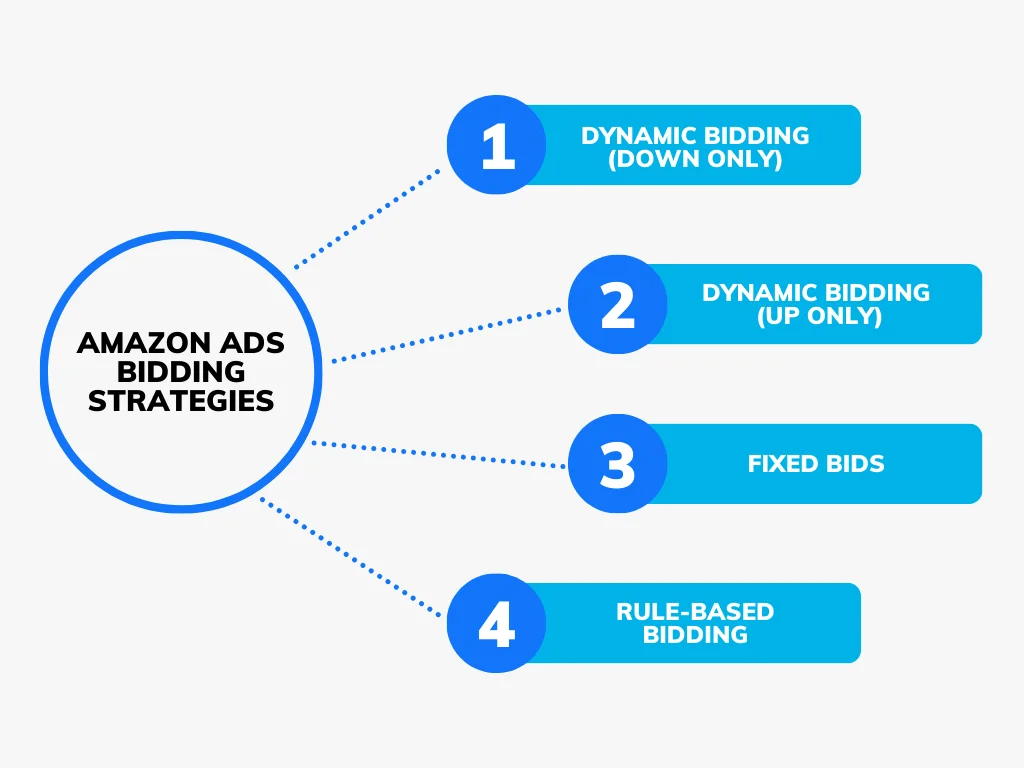Digital marketing and advertising on Amazon have undergone a turbulent transformation. Amazon advertisements generate a lot of money for sellers, but there’s a lot of competition. Getting one’s products in front of the most significant potential audience is a top priority for every seller on Amazon.
However, the cost of advertising on the platform is increasing as brands become more and more competitive. 38% of Amazon sellers are concerned about increasing ad costs on Amazon in 2023.
How Do Amazon Ads Work?
Visit the Register page and enroll in one of the self-service advertising packages, such as Sponsored Products, Sponsored Brands, Sponsored Displays, or Stores.
You can independently work with an Amazon advertisements account executive or handle display, video, and DSP advertisements.
Types Of Amazon Sponsored Ads For Amazon Sellers:
According to the ecommerce data compiled by Jungle Scout, the ad type sellers and brands prefer is Sponsored Products. However, advertising budgets have shifted in the past three years away from Sponsored Products and toward Sponsored Brands and Sponsored Display ads, suggesting that sellers see value in building a presence for their brands on Amazon in addition to their products.
Sponsored Products Ads
The most common kind of Amazon PPC advertising is Amazon’s Sponsored Products. They are utilized for product promotion and can be seen on Amazon search results pages and product detail pages.
These commercials are a breeze to put up, and you can go with either an automated or a manual campaign. In-depth information about Sponsored Products and the various targeting options is available on this blog.
Sponsored Display Ads
Retargeting with these ads is a breeze. The people who see them are likely to have bought or seen products similar to yours. Unlike the other two types of Amazon PPC advertising, these can reach people on and off Amazon.
Displayed on Amazon’s home page, product detail pages, and search engine results pages (SERPs), sponsored display advertising can get your business in front of more people.
Brands advertising on Amazon were surveyed, and 61% of them stated they used Sponsored Product ads, 54% said they used Sponsored Brands, and 54% said Sponsored Displays (source).
Sponsored Brands Ads
Only vendors with active Amazon Brand Registry accounts can see this Amazon ads campaign. Commercials like these showcase a brand’s emblem and a slogan to sell more than one product at a time. Increase your brand’s visibility, awareness, and presence with this advertising.
If you want to know how to make the most of it, see SellerApp’s blog post on advanced brand ad techniques. Clicking on these will take clients to your Amazon storefront, where you can showcase your products or guide them to a specific listing.
Amazon PPC Advertising Cost In Simple Words:
Amazon ads campaign is a must, regardless of the product you sell on the platform. To make an informed decision about your marketing budget, you must know how much these ads cost. So, how much is the going rate for Amazon PPC advertising? Several variables affect the final price, including the ad’s kind, the cost-per-click (CPC), your bidding strategy, the keywords you choose, the level of competition, and so on.
Your daily budget, ad targeting type, bids per keyword, and ad kinds selected all play a role in determining how much it will cost to advertise on Amazon. More goes into it than just letting you choose your daily spending limit.
You can run a successful Amazon ads campaign with as little as $10 a day, but you’ll lose even more if it loses money. Although it’s essential to include appropriate keywords in your ads, other critical aspects that affect ad conversions include the product type, pricing, listing photos, and reviews.
Your conversion rate will be lower than your competitors if you direct customers to an unoptimized listing.
Amazon PPC advertising is relatively cost-effective, but there is no magic formula. Every product, market segment, and vendor will have their unique challenges. Improving your listings and Amazon PPC management to maximize conversions and return on ad spend takes time and effort.
Amazon Sponsored Products Ads Vs Brands Ads
All three types of Amazon PPC advertising remain lucrative methods to market your products on Amazon, even though the average Return on Ad Spend (ROAS) for each Amazon PPC Ad Product declined year-over-year.
When comparing Sponsored Brands, Sponsored Display, and Sponsored Products, the ecommerce data shows that Sponsored Products has the best return on ad spend (RoAS).

Sellers without a registered brand can still benefit from Sponsored Products Ads. This Amazon ads campaign is incredibly user-friendly and lets you reach your target audience right from the start of your launch. You may still uniquely display your products and turn visitors into buyers with this ad type, even though it’s accessible to all professional sellers.
Your campaigns’ profitability is directly proportional to their RoAS. Jungle Scout analysis shows that Sponsored Display ads have a lower RoAS than the other two Amazon PPC advertising methods. However, they may be better for visibility and brand recognition than revenue in this scenario. You can reach relevant people on and off the platform with these advertisements, even though your return on these Amazon ads campaign may be lower with Sponsored Displays.

What Is RoAS And How Is It Calculated?
As previously stated, the return on ad spend (RoAS) of any Amazon PPC advertising is calculated by dividing total sales by total spend. Simply put, return on ad spend (RoAS) determines an advertising budget’s return on investment (ROI).
Therefore, RoAS is tightly related to your ROI of the running Amazon ads campaign. While return on investment (ROI) is excellent for taking a bird’s-eye view of your marketing efforts, return on ad spend (RoAS) allows you to drill down to the performance of individual campaigns, ads, or even keywords.
Advertisers value RoAS highly since it is a very adaptable metric. Your RoAS can help you evaluate the effectiveness of different ad sets, changes to targeting, and more.

Among RoAS’s many advantages is the relative ease with which it may be computed. Amazon uses an index (multiplier) instead of a percentage to describe RoAS, while there are other ways to put it.
How Much Are Amazon Ads, And What Should Be My Budget?
The goals of the Amazon ads campaign also have a role in determining the budget. Each ad format on Amazon is designed to accomplish a specific goal. Sellers can choose from the three Amazon PPC advertising formats discussed above. However, Amazon-sponsored product ads have been the top choice for many advertisers worldwide.
The reason is that they are a great and quick way to advertise your items, and they are also inexpensive. But Amazon ads campaign are no longer priced solely based on performance. They are oblivious that it provides them with publicity, brand recognition, sales, and many other advantages. As an example, let’s examine Sponsored Brands. Advertisers have a lot of leeway to personalize their ads, and they even let you compete for ad placement.
Amazon PPC management expert who want to increase exposure and presence on Amazon for their brand are allocating the brand’s marketing budgets to Sponsored Display, which has grown popular but may be slightly more expensive. Although the return on ad spend (RoAS), as mentioned above, is lower but they help promote your products and reach buyers on and off Amazon.
Expert Recommended Daily Spending Budget For Sponsored Ads:
Though $50–$100 per day is where JungleScout suggests you begin with pay-per-click ads, you can certainly begin with $5–$10 per day and tweak as needed. While your Amazon ads campaign run, collect data to help you decide which keywords to target, how much to bid on each term, and how to optimize your listings. Be mindful of your budget; premature depletion will result in pausing your campaigns. To avoid running out of money, just raise your daily budget if you’re making money, or get rid of or replace expensive keywords that aren’t bringing in any sales. To stay on the safe side sellers can partner with their local Amazon PPC agency to maximize ROI on your advertising budget.
What matters most is that your daily budget is profitable and yields a positive return on investment; otherwise, it makes no difference.
What Are Amazon PPC Advertising Bidding Strategies:
Here are the four most common and result-yielding bidding strategies every Amazon PPC management expert must know about:

1. Fixed Bidding
If you use Fixed bids, you can select a default bid that will remain unchanged regardless of conversions or other changes.
2. Rule-based Bidding
In this strategy, we target a particular RoAS by having sellers establish their own rules and conditions for bidding. Using “if/then” rules, sellers can manually establish circumstances that, when satisfied, will cause changes to bids and keywords
3. Dynamic bidding (down)
This is your bidding method if you still need to be well-versed in Amazon PPC advertising. Optimizing ad spending is made easier with its ability to reduce bids by up to 100% when the likelihood of a click converting into a sale is low.
4. Dynamic bidding (up and down)
This type of bidding is when Amazon increases your bid by up to 100% if there is a high possibility of making sales or lowers your bid by up to 100% when there isn’t any room for conversions.
Partner With The Amazon PPC Management Expert
If you’re looking for a reliable Amazon PPC agency for efficient and effective Amazon PPC management, contact the AMZDUDES. By sorting keywords by ACoS, non-performing keywords, order quantity, and other metrics, our experts will optimize your campaigns for maximum conversions.
With this knowledge and expertise, you will see visible results in your Amazon sales and campaign performance. Get in touch with AMZDUDES Amazon PPC management experts today to ensure your marketing budget is wisely invested with guaranteed maximum ROI.

![How Much Are Amazon Ads In The USA [2024]](https://amzdudes.com/wp-content/uploads/2024/01/How-Much-Are-Amazon-Ads-In-The-USA-2024.webp)


